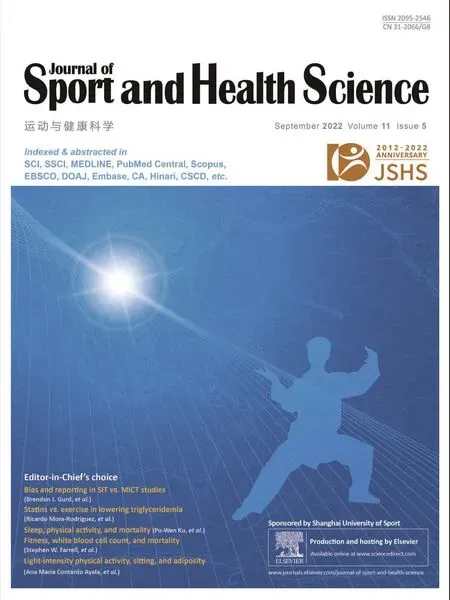Step volume and intensity in older adults:Commentary on“Association of accelerometer-derived step volume and intensity with hospitalizations and mortality in older adults:A prospective cohort study”
Cayla McAvoy,Catrine Tudor-Locke
College of Health and Human Services,University of North Carolina at Charlotte,Charlotte,NC 28223,USA
In 2021,Ma~nas et al.1used data from the Toledo Study for Healthy Aging and reported that high accelerometer-derived step volume and(what they labeled)intensity were significantly associated with lower hospitalization(average followup=3.1 years)and all-cause mortality(average followup=5.7 years)in 768 older adults(average age=78.8±4.9 years,mean±SD).Step volume(expressed as steps/day)was averaged across all compliant days(i.e.,those with≥8 h/day of valid wear time).For their purposes,the authors defined intensity as the total step volume divided by the total valid minutes of accelerometer wear time.They reported this value in steps/min units,implying a“cadence”that has indeed been associated with intensity measured as oxygen consumption.2However,true cadence is a stepping rate,literally an unmanipulated count of steps taken in a minute,and can be directly extracted from each minute recorded with time-stamped accelerometers like that used in the Toledo Study.1
A consistent cadence-based threshold associated with absolutely-defined moderate intensity across the adult lifespan is 100 steps/min.3-5We6and others7have also used peak cadence indices to provide uncomplicated measures of best natural effort.For example,peak 30-min cadence is calculated as the average steps/min from the 30 highest,not necessarily consecutive,minutes in a day.8In a secondary analysis of the 2005-2006 National Health and Nutrition Examination Survey accelerometer data collected from 3725 adults(ages 20-80+years),the average daily value for peak 30-min cadence was 72 steps/min.9Using the 2011-2015 Women’s Health Study data,Lee et al.7reported an average peak 30-min cadence value of 58 steps/min based on 16,741 older adult women(ages 62-101 years).Another way to express intensity with stepbased metrics is to examine time spent above specific cadence thresholds,such as≥40 steps/min,2,7a marker of purposeful movement(as opposed to incidental movement),or≥100 steps/min as a proxy indicator of absolutely defined moderate intensity.3-5Results from the population-level National Health and Nutrition Examination Survey analysis mentioned above9revealed that U.S.adults averaged 39 min/day in purposeful movement(defined as 40-59 steps/min),5 min/day briskly walking(100-119 steps/min),and 1.5 min in faster locomotion(≥120 steps/min).9
In contrast to some of the above metrics,Ma~nas et al.1reported intensity as 7.3 steps/min based on 5835 steps/day divided by about 12.8 h/day of wear time.The value reported by Ma~nas et al.1appears to be shockingly small relative to these other published values using peak cadence indices,7,9but is consistent with other reports that have computed a daily average steps/min value in a similar manner.Schuna et al.9reported that U.S.adults 20-80+years of age averaged 7.7 steps/min and Matthiessen et al.10reported 9.4 steps/min in Danish adults 18-75 years of age.However,expressed in this way,such values do not represent true cadence.Instead,they are composite indices that reflect effort that is greatly diluted,or zero-inflated,by time worn detecting non-movement(i.e.,dominant data arrays of zero or near-zero minutes).Even though Ma~nas et al.1reported their data in a steps/min unit,and their findings were provocative and worthy of additional exploration,future analyses should attempt to isolate the pure influence of cadence-defined intensity(perhaps as a peak cadence index,or time spent above specific cadence thresholds,as described above)vs.an index that is distorted by the zero-diluting effects of device time worn and specifically the dominance of time spent in non-movement.
We also have questions about the analytical approach used.Ma~nas et al.1reported individual and joint associations of step volume and intensity with hospitalizations and all-cause mortality.However,they failed to evaluate the collinearity of these 2 variables that were distilled from the same data signal reflective of enacted ambulatory movement,and thus,not independent.There is a known relationship between different step metrics such as steps/day,steps/min,peak cadence,wear time,and non-movement time,6and the correlation between steps/day and various step intensity metrics(e.g.,peak 1-min cadence;peak 30-min cadence;maximum 5-min cadence;time spent at a stepping rate of≥40 steps/min)is strong(r≥0.8;p<0.001).7Ma~nas et al.1acknowledged indirect evidence of a relationship between the 2 step metrics in their analysis,but previous research has shown that controlling for steps/day neutralizes the effect of step-based intensity metrics on various outcomes.For example,Lee et al.7stated that“after accounting for number of steps taken,all stepping-intensity associations were attenuated”.Additionally,in their study on step-based metrics and cardiometabolic risk factors,Tudor-Locke et al.6reported that there is“an obvious potential confounder in the apparent relationships between the different step-based metrics.”Ma~nas et al.1concluded that both step volume and step-based intensity metrics were associated with hospitalizations and all-cause mortality,because they did not extend their analysis to determine whether controlling for step volume altered the effects of their chosen intensity metric.
We commend Ma~nas et al.1for their work and acknowledge that step-based intensity metrics are nascent concepts.One of the clear benefits of step counting and cadence tracking is the simplicity of these metrics and the ease at which they can be translated and implemented.However,the results presented by Ma~nas et al.1beg the question—is walking 7.3 steps/min a metric that can be simply translated from research findings into public health use?Also,do older adults understand how to walk in such a way as to elicit an overall average of 7.3 steps/min throughout their day?We look forward to continuing to learn from Ma~nas et al.1and other researchers as this line of research is pushed forward.
Authors’contributions
CM drafted the initial version of this commentary;CTL edited the paper and provided key subject matter information.Both authors have read the approved the final version of the manuscript,and agree with the order of presentation of the authors.
Competing interests
Both authors declare that they have no competing interests.
 Journal of Sport and Health Science2022年5期
Journal of Sport and Health Science2022年5期
- Journal of Sport and Health Science的其它文章
- Do multiparous women need to work or exercise extra hard to control gestational diabetes?
